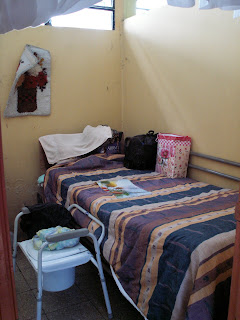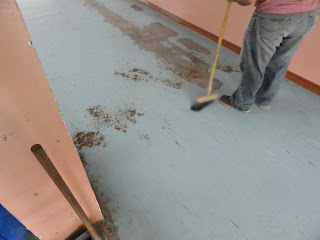Sadly, I am not the only one who is misinformed about leprosy. It is such a scary disease to most people that we were instructed not to call it leprosy in the countries where it is more common because of the general fear and misconceptions behind it. People are shunned if they have leprosy. Leprosy is also called Hansen's disease. The term of Hansen's disease does not instill fear in people so it allows for better treatment of the patients.
Hansen's disease (leprosy) is in fact, not very contagious at all. Only 5% of the entire human population are even susceptible to it. And if you are one of the 5%, you have to have long periods of time (months to years) of direct person-to-person contact. It can not be spread through skin or by touching someone who has Hansen's disease. It is spread similarly to a cold, through the droplets in the air.
Hansen's Disease is rare in developed countries such as the United States. But it is very common in third world areas of Asia, Africa, and South America. However, "leprosy could be eradicated worldwide, if that goal were to be set," according to Dr. Julie Gerberding, the director of the United States Center for Disease Control.
The kicker of this disease is that if it is diagnosed early, it requires a very simple treatment. The treatment??? One little pill. Most cases are not diagnosed early and are far into the disease before they get treatment. If this happens they require a longer regimen of treatment, 6 months to 2 years. But no matter how long they have had it, leprosy is completely curable. The side effects of the disease with those who have had it for a long time, unfortunately, are not curable.
Patients who have had Hansen's disease for a long time suffer from neuropathy, similar to diabetics, they lose feelings in the fingers, toes, feet, etc. Since this is mainly a third world disease, most of these people work with their hands and are on their feet every day. So what commonly happens is they hurt themselves while working and they can't feel it so they keep hurting themselves over and over again. Eventually, the human body starts to withdraw itself from recurrent injury, which is why many patients have hands and feet that look like they are missing fingers and toes.
This is obviously my description to Hansen's disease. If you want a more comprehensive and/or professional explanation, http://www.thedamienhouse.org/index.html. Which is the web site to the actual place we went in Ecuador, the Damien House. The Damien House is home to 60 Hansen patients and treats about 700 outpatients.

 We brought a lot of medical supplies to Ecuador. This is a picture of the supplies we brought to the Damien House.
We brought a lot of medical supplies to Ecuador. This is a picture of the supplies we brought to the Damien House. The men playing dominoes...
The men playing dominoes... This is a picture of Sister Annie, a nun who has been volunteering here since the 1980s. She totally transformed the Hansen's disease wing of the hospital and created the Damien House. She has been there ever since. Pretty amazing woman!! The guy in the picture lives at the Damien house, it was his birthday! I don't remember how old he was, but he was over 80!
This is a picture of Sister Annie, a nun who has been volunteering here since the 1980s. She totally transformed the Hansen's disease wing of the hospital and created the Damien House. She has been there ever since. Pretty amazing woman!! The guy in the picture lives at the Damien house, it was his birthday! I don't remember how old he was, but he was over 80!
This picture has a funny story! This is a room where new patients stay and get treated. They turned off the guy's TV while we were there. Once we had left, Sister Annie tried to turn the TV back on, for a good couple minutes, before the cute old man informed her that she was trying to turn the TV back on with the air conditioning remote control!:)
 Me and one of the men who live at the Damien House.
Me and one of the men who live at the Damien House.
This is the birthday boy who brought out his hammocks that he makes by hand! Over 80-years-old and makes these phenomenal hammocks. $20 a piece! What a deal!
 Ok, I look like an evil freak of nature in this picture. But it has a good story. We were in a room that had four old men in it, all who were various degrees of sick. One little old guy sang songs for us and than one of our translators sang a song. The lady in charge tells me to sing something. The only thing I can think of is 'Once There Was a Snow Man', which I sang along with all the movements. I looked and sounded ridiculous, but whatever, I was the only one of us who would sing something. And how could anyone say no to these super cute old people?
Ok, I look like an evil freak of nature in this picture. But it has a good story. We were in a room that had four old men in it, all who were various degrees of sick. One little old guy sang songs for us and than one of our translators sang a song. The lady in charge tells me to sing something. The only thing I can think of is 'Once There Was a Snow Man', which I sang along with all the movements. I looked and sounded ridiculous, but whatever, I was the only one of us who would sing something. And how could anyone say no to these super cute old people?
A picture of one of the men's rooms. There are three beds in this room.
 The hallway of the women's area. The bedrooms are on each side.
The hallway of the women's area. The bedrooms are on each side.
A picture of the lady's bathroom.
 Half of one of the lady's rooms. There are two beds in each of the girl's rooms.
Half of one of the lady's rooms. There are two beds in each of the girl's rooms. Me and one of the ladies...
Me and one of the ladies... The Damien house appeared to be a happy place. Lots of cute people! Most of them made and sold things, like the guy's hammock or the women who made jewelry and sold it to us. Everyone seemed happy and well loved!
The Damien house appeared to be a happy place. Lots of cute people! Most of them made and sold things, like the guy's hammock or the women who made jewelry and sold it to us. Everyone seemed happy and well loved!
























